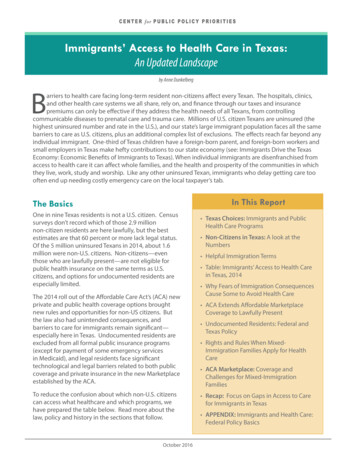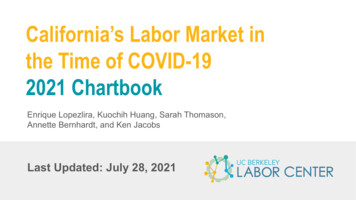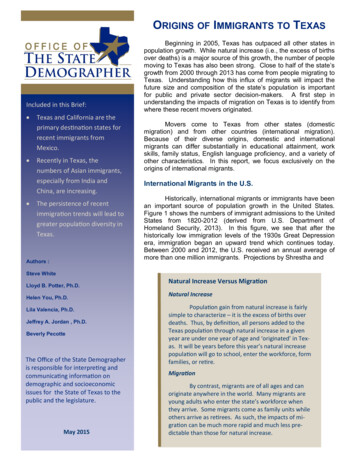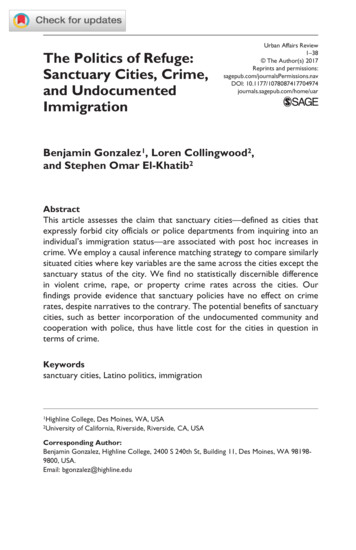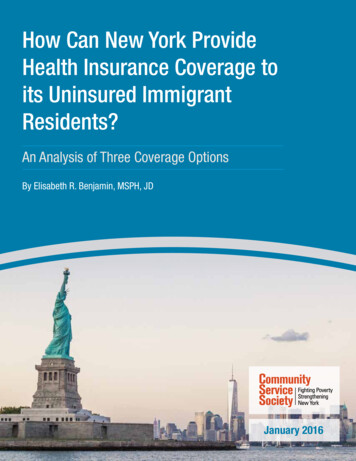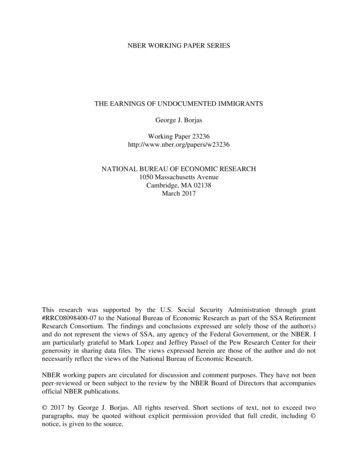
Transcription
NBER WORKING PAPER SERIESTHE EARNINGS OF UNDOCUMENTED IMMIGRANTSGeorge J. BorjasWorking Paper 23236http://www.nber.org/papers/w23236NATIONAL BUREAU OF ECONOMIC RESEARCH1050 Massachusetts AvenueCambridge, MA 02138March 2017This research was supported by the U.S. Social Security Administration through grant#RRC08098400-07 to the National Bureau of Economic Research as part of the SSA RetirementResearch Consortium. The findings and conclusions expressed are solely those of the author(s)and do not represent the views of SSA, any agency of the Federal Government, or the NBER. Iam particularly grateful to Mark Lopez and Jeffrey Passel of the Pew Research Center for theirgenerosity in sharing data files. The views expressed herein are those of the author and do notnecessarily reflect the views of the National Bureau of Economic Research.NBER working papers are circulated for discussion and comment purposes. They have not beenpeer-reviewed or been subject to the review by the NBER Board of Directors that accompaniesofficial NBER publications. 2017 by George J. Borjas. All rights reserved. Short sections of text, not to exceed twoparagraphs, may be quoted without explicit permission provided that full credit, including notice, is given to the source.
The Earnings of Undocumented ImmigrantsGeorge J. BorjasNBER Working Paper No. 23236March 2017JEL No. J31,J61,J68ABSTRACTOver 11 million undocumented persons reside in the United States, and there has been a heateddebate over the impact of legislative or executive efforts to regularize the status of thispopulation. This paper examines the determinants of earnings for undocumented workers. Usingnewly developed methods that impute undocumented status for foreign-born persons sampled inmicrodata surveys, the study documents a number of findings. First, the age-earnings profile ofundocumented workers lies far below that of legal immigrants and of native workers, and isalmost perfectly flat during the prime working years. Second, the unadjusted gap in the log hourlywage between undocumented workers and natives is very large (around 40 percent), but half ofthis gap disappears once the calculation adjusts for differences in observable socioeconomiccharacteristics, particularly educational attainment. Finally, the adjusted wage of undocumentedworkers rose rapidly in the past decade. As a result, there was a large decline in the wage penaltyassociated with undocumented status. The relatively small magnitude of the current wage penaltysuggests that a regularization program may only have a modest impact on the wage ofundocumented workers.George J. BorjasHarvard Kennedy School79 JFK StreetCambridge, MA 02138and NBERgborjas@harvard.edu
3The Earnings of Undocumented ImmigrantsGeorge J. Borjas *I. IntroductionThe Department of Homeland Security (DHS) estimates that over 11 millionundocumented persons resided in the United States in January 2012. In the past few years,Congress considered (but failed to enact) a number of proposals that would regularize the statusof the undocumented population and provide a “path to citizenship.” Similarly, President Obamaissued executive orders that would grant some form of amnesty to about half of this population,but courts ruled that the executive branch may lack such authority.Given the size of the undocumented population, any future change in the immigrationstatus of this group is bound to have significant effects on the labor market and the broadereconomy. However, any evaluation that attempts to predict the economic impact ofregularization immediately runs into a major roadblock. It is difficult to conduct such acalculation because we know little about the economic status of the 11 million undocumentedpersons already living in the United States.The documentation of the economic status of this population is obviously hampered bythe fact that no widely available microdata survey reports whether a particular foreign-bornperson is undocumented or not. In recent years, however, there has been progress in developingmethods that attempt to impute the undocumented status of foreign-born persons at theindividual level in microdata sets, such as the Current Population Surveys or the American* This research was supported by the U.S. Social Security Administration through grant #RRC08098400-07to the National Bureau of Economic Research as part of the SSA Retirement Research Consortium. The findings andconclusions expressed are solely those of the author(s) and do not represent the views of SSA, any agency of theFederal Government, or the NBER. I am particularly grateful to Mark Lopez and Jeffrey Passel of the Pew ResearchCenter for their generosity in sharing data files.
4Community Surveys. These attempts build on the framework first proposed by Warren andPassel (1987) that attempts to estimate the size of the undocumented population. The PasselWarren methodology, in fact, underlies the “official” estimates of this population as reported byDHS.Jeffrey Passel (now at the Pew Research Center) and various colleagues have continuedto improve and extend the initial methodology over the past two decades. As part of this work,they have constructed micro-level CPS files that contain a variable indicating if a foreign-bornperson is “likely authorized” or “likely unauthorized.” I was granted access to the 2012-2013Annual Socioeconomic and Economic Supplements (ASEC) created by the Pew Research Centerthat contains the undocumented status identifier. After carefully examining the Pew methodology,I adapted and extended their approach so that I could create an undocumented status identifier inother micro data files, including all the ASEC files where foreign-born status is reported (i.e., allthe ASEC files beginning in 1994) and the American Community Surveys (ACS). This extensionof the Pew approach yields a time series of individual-level data that allows us to document andexamine the determinants of key characteristics of the undocumented population.Borjas (2018) began such an analysis by studying differences in labor supply behavioramong undocumented immigrants, legal immigrants, and natives. The differences in workpropensities were striking. Undocumented men had much larger labor force participation andemployment rates than other groups in the population; the gap widened substantially over thepast two decades; and the labor supply elasticity of undocumented men was close to zero,suggesting that their labor supply is very inelastic. In contrast, undocumented women had muchlower participation and employment rates than other groups in the population.
5Building on this earlier work, this paper extends the analysis to an examination of thewage differences that exist among the various groups. The analysis of both the CPS and the ACSyields a number of potentially important findings:1. The (cross-section) age-earnings profiles of undocumented workers lies far below thatof legal immigrants and of native workers. Moreover, the (cross-section) age-earnings profile ofundocumented workers is almost perfectly flat during much of the prime working years.2. Although the unadjusted gap in the log hourly wage between undocumented workersand natives is large (around 40 percent for both men and women), half of the gap disappears afteradjusting for differences in observable socioeconomic characteristics. The wage gap betweenobservationally equivalent undocumented workers and natives (adjusted for age, education, andstate of residence) is less than 20 percent for both men and women.3. The adjusted wage of undocumented workers rose rapidly in the past decade, relativeto that of both native workers and legal immigrants.4. The rise in the adjusted wage of undocumented workers implies that the wage penaltyto undocumented status fell dramatically in the past few years. This wage penalty, defined as thewage gap between observationally equivalent undocumented and legal immigrants, was about 10percent in 2005, but fell to less than 4 percent by 2014. The small magnitude of the current wagepenalty suggests that the enactment of a regularization program may only have modest effects onthe wage of undocumented workers.5. The higher employment rates of undocumented men imply that the total earnings gap(the gap that includes both the difference in the wage rate and differences in labor supply) is farsmaller than suggested by the gap in the hourly wage rate. In contrast, the lower employment
6rates of undocumented women imply that the total earnings gap is far larger than suggested bythe gap in the hourly wage rate.This diverse set of findings provides a foundation upon which any eventual impactanalysis of the various regularization proposals can be based. It is important to acknowledge atthe outset, however, that the robustness of the evidence depends on the validity of the procedureused to impute undocumented status at the micro level.II. Imputing Undocumented Status in Microdata FilesWarren and Passel (1987) introduced the “residual” methodology used by the DHS tocalculate the size of the undocumented population. The first step involves estimating how manylegal immigrants should reside in the United States at a point in time. Over the years,immigration officials have tracked the number of legal immigrants admitted to the country (i.e.,the number of “green cards” granted each year). We also know how many foreign-born personslive in the United States temporarily (e.g., foreign students, business visitors, diplomats, etc.).These data enable us to apply mortality tables to the cumulative count of green cards and predicthow many legal immigrants should be residing in the United States at any given point in time.At the same time, many government surveys, such as the decadal census, enumerate orsample the U.S. population and specifically ask where each person was born. These surveysprovide estimates of how many foreign-born people are actually living in the country. In roughterms, the difference between the number of foreign-born persons who are actually living in the
7United States and the number of legal immigrants who should be living in the United States isthe Warren-Passel (and now “official” DHS) estimate of the number of undocumented persons. 1Jeffrey Passel has continued to work on the identification and enumeration ofundocumented immigrants over the past two decades. As a result of these efforts, Passell (andcolleagues at the Pew Research Center) have developed a comparable methodology that attemptsto identify the undocumented immigrants at the individual level in survey data. This importantextension of the Warren-Passel methodology relies on the same residual approach that wasinitially used to calculate the size of the undocumented population.Passel and Cohn (2014) describe the methodology used to add an undocumented statusidentifier to the Annual Social and Economic Supplement (ASEC) files of the CPS. In roughterms, the methodology identifies the foreign-born persons in the sample who are likely to belegal, and then classifies the residual group as likely to be undocumented. In particular:All immigrants entering the U.S. before 1980 are assumed to be legal immigrants.Then, the CPS data are corrected for known over-reporting of naturalizedcitizenship on the part of recently arrived immigrants and all remainingnaturalized citizens from countries other than Mexico and those in CentralAmerica are assigned as legal. Persons entering the U.S. as refugees are identifiedon the basis of country of birth and year of immigration Then, individualsholding certain kinds of temporary visas (including students, diplomats and “hightech guest workers”) are.assigned a specific legal temporary migrationstatus Finally, some individuals are assigned as legal immigrants because theyare in certain occupations (e.g., police officer, lawyer, military occupation, federaljob) that require legal status or because they are receiving public benefits (e.g.,1 Note that government surveys, including the decadal census, miss many people. Some of the peoplemissed are undocumented immigrants who wish to avoid detection. To calculate an estimate of the size of theundocumented population, the Warren-Passel methodology must make an assumption about the undercount rate.The DHS assumes that the undercount for undocumented persons is 10 percent (Baker and Rytina, 2013, p. 6).
8welfare or food stamps) that are limited to legal immigrants. As result of thesesteps, the foreign-born population is divided between individuals with “definitelylegal” status and a group of “potentially unauthorized” migrants [There isalso] a check to ensure that the legal statuses of family members are consistent;for example, all family members entering the country at the same time areassumed to have the same legal status (Passel and Cohn, p. 23).Passel and Cohn (2014) observe that this approach leads to “too many” undocumentedimmigrants. They then apply a filter to ensure that the counts from the microdata agree with thereported DHS numbers: “To have a result consistent with the residual estimate of legal andunauthorized immigrants, probabilistic methods are employed to assign legal or unauthorizedstatus to these potentially unauthorized individuals.” The CPS sample is then reweighted so thatthe aggregate count of undocumented immigrants matches as closely as possible the DHSestimates.I was granted access to the 2012-2013 ASEC files that are maintained by the PewResearch Center. Figure 1 illustrates the percent of the U.S. population by age that is imputed tobe undocumented in the Pew ASEC files. The DHS official counts imply that 3.7 percent of theU.S. population is undocumented. The Pew files suggest that a very high fraction (almost 10percent) of persons in their early 30s are undocumented.After being granted access to the Pew ASEC files (but not to the underlying code), Iexamined the demographic characteristics of those persons identified as undocumentedimmigrants in the pooled 2012-2013 cross-sections. Despite the inherent complexity in theresidual method of identifying the subsample of the likely undocumented, it turns out that only arelatively small number of variables “matter” in the mechanical process of creating theundocumented identifier. This fact suggests that it may be possible to reverse engineer the
9method to create a comparable undocumented identifier in all of the ASEC files since 1994 aswell as in other data sets.The algorithm I use to create a comparable undocumented status identifier in all therelevant ASEC files is as follows. A foreign-born person is classified as a legal immigrant if anyof the following conditions hold:a. that person arrived before 1980;b. that person is a citizen;c. that person receives Social Security benefits, SSI, Medicaid, Medicare, or MilitaryInsurance;d. that person is a veteran, is currently in the Armed Forces;e. that person works in the government sector;f. that person resides in public housing or receives rental subsidies, or that person is aspouse of someone who resides in public housing or receives rental subsidies;g. that person was born in Cuba (as practically all Cuban immigrants were granted refugeestatus);h. that person’s occupation requires some form of licensing (such as physicians, registerednurses, air traffic controllers, and lawyers);i. that person’s spouse is a legal immigrant or citizen.The residual group of all other foreign-born persons is then classified as undocumented.Unlike the Pew methodology, my reconstruction of the undocumented identifier does not involveany kind of probabilistic sampling to account for the “excess” number of undocumentedimmigrants that this method yields, nor does it reweight the data to ensure that the total counts ofthe undocumented match the DHS official counts.As Figure 1 shows, the predicted fraction of undocumented immigrants in the populationat any particular age is essentially the same regardless of whether I use the Pew files or the
10reconstructed CPS files. This similarity suggests that it may be possible to extend the exercise tocreate an undocumented status identifier for all foreign-born persons sampled by the CPSthroughout the entire 1994-2014 period, as well as extend the methodology to other microdatafiles, such as the American Community Surveys (ACS), which contain much larger samples ofthe population.I applied the algorithm to the pooled 2011-2012 ACS files, and Figure 1 also illustratesthe age profile in the fraction of the population that is undocumented. 2 It is evident that thefraction of persons who are imputed to be undocumented closely tracks the fraction predicted bythe Pew CPS files, suggesting that the ACS can perhaps be fruitfully used to study differences inthe wage structure among the various groups. It is crucial to emphasize yet again, however, thatthe validity of the evidence obviously depends on the accuracy of the process used to imputeundocumented status in the original Pew algorithm. In the absence of administrative data on thecharacteristics of the undocumented population, it is not possible to quantify the direction andmagnitude of any potential bias.Table 1 reports summary statistics for the male sample of working natives, legalimmigrants, and undocumented persons in each of the three data extracts (i.e., the Pew CPS files,my reconstruction of the CPS files, and the ACS). The sample is restricted to men aged 25-64who are not enrolled in school, are not self-employed, and report positive wage and salaryincome, positive weeks worked, and positive usual hours worked weekly.There is a lot of similarity in the characteristics of the three groups across the dataextracts. The fraction of the population that is undocumented is 6.9 percent in the Pew CPS, 7.4percent in the reconstructed CPS, and 6.8 percent in the ACS). The average age of2 The only difference in the algorithms applied to the CPS and ACS data arises because the ACS does notidentify whether a particular household is living in public housing or is receiving subsidized rents.
11undocumented immigrants is practically identical in all three files (at 37.2 years). Similarly, 45.5of undocumented persons in the Pew files are high school dropouts, as compared to 42.2 percentin the reconstructed ASEC files, and 43.7 percent in the ACS files.I also calculated the hourly wage rate for each worker in the sample (defined as wage andsalary income divided by the product of weeks worked in the past year and usual hours workedweekly). Table 1 shows that the log wage gap between undocumented workers and natives issimilar across the data sets. The wage disadvantage of undocumented workers is -0.455 logpoints in the Pew CPS; -0.452 log points in the reconstructed CPS; and -0.404 in the ACS data.III. Wage Differences across GroupsI begin by examining the determinants of the differences in the log hourly wage rateacross the various groups. Initially, I use the pooled 2012-2013 ASEC files created by Passel andcolleagues at the Pew Research Center and restricted to workers aged 21-64, as well as thereconstructed CPS files and ACS files described in the previous sections that cover the sametime period. 3 Throughout this section, I will pool the two cross-sections and treat them as asingle data set.It is useful to begin by simply illustrating the differences in the age-earnings profilesacross the three groups implied by the raw data. Figure 2 shows the age-earnings profiles in thesample of working men, while Figure 3 shows the corresponding profiles in the sample ofworking women. Figure 4 summarizes by contrasting the age-earnings profiles of undocumented3 Because the CPS reports earnings in the previous calendar years, the analysis uses the comparable2011 and 2012 cross-sections of the ACS.
12workers across the three data extracts. The figures suggest a number of interesting findings thatare common across the different data sets examined.First, and most important, the (cross-section) age-earnings profiles of undocumentedworkers lie far below those of the other two groups and are relatively flat. At the age of 25, forexample, the hourly wage of undocumented workers in the ACS is 0.23 log points below that ofnatives and 0.17 log points below that of legal immigrants. By age 45, the wage gap betweennatives and undocumented immigrants rose to 0.51 log points, while the wage gap between legalimmigrants and undocumented workers rose to 0.39 log points.Second, note that the pattern of lower and flatter age-earnings profiles for undocumentedworkers is observed both among working men and among working women. In each case, thehourly wage rate of undocumented workers reveals remarkably little growth during the primeworking years between the ages of 30 and 50.Finally, as Figure 4 shows, the three alternative data sets show very similar age-earningsprofiles for undocumented workers. In other words, the application of the reverse-engineeredPew algorithm to alternative data sets provides a consistent picture of earnings over the life cyclefor undocumented workers. It is worth noting that the much larger samples available in the ACSsmooth out the year-to-year noise.It is important to emphasize that it is difficult to interpret the cross-section age-earningsprofiles of both legal, and particularly, undocumented workers as measuring some type of wageevolution over the life cycle. It is well known (Borjas, 1985) that cross-section age-earningsprofiles of immigrants are affected by both assimilation effects, the wage growth that occurs as aparticular immigrant gets older, and by cohort effects, the differences in earnings potential acrosswaves of immigrants that entered the United States at different times. The wage evolution of the
13undocumented sample is also affected by the fact that some of the undocumented will be able to“filter themselves” out and obtain green cards as they age, joining the legal sample, and by thefact that changes in the legal infrastructure regulating illegal immigration (such as nonenforcement of existing laws or enactment of new penalties) might affect the flow ofundocumented workers in and out of the country over time. Some of these issues are discussed ingreater detail in subsequent sections.To document the determinants of the large wage disadvantage experienced byundocumented workers, particularly when compared to native workers, I estimated the followingregression model:(1)log wi δt θ Xi β1 Li β2 Ui εi,where wi is the hourly wage rate of worker i; δt is a dummy variable indicating if the observationis drawn from the 2012 or 2013 cross-section in the CPS (or the 2011 or 2012 cross-section inthe ACS); Xi is a vector of socioeconomic characteristics described below; Li is a dummyvariable indicating if the worker is a legal immigrant; Ui is a dummy variable indicating if theworker is an undocumented immigrant; and the excluded group indicates if worker i is nativeborn. The coefficients β1 and β2 measure the log wage gaps between the two foreign-born groupsand the native-born workforce. The regressions are estimated separately for men and women.The first two columns of Table 2 report the regression coefficients for men, while the lasttwo columns report the respective coefficients for women. Each panel in the table reports theestimated coefficients in each of the three alternative data files. As row 1 of each panel shows,the unadjusted log wage gap between undocumented immigrants and natives is -0.46 in the Pew
14files; -0.45 in the reconstructed CPS, and -0.40 in the ACS. It is evident that much of the wagegap between undocumented immigrants and natives can be explained by differences ineducational attainment. The education- and age-adjusted wage disadvantage of undocumentedmen reported in row 3 falls to -0.18 in the Pew CPS, -0.19 in the reconstructed CPS, and -0.15 inthe ACS. Even after adjusting for the fact that undocumented immigrants tend to cluster in asmall number of states, the wage disadvantage of undocumented workers relative to nativesremains sizable, hovering around -0.20 log points in the various data extracts.The regression coefficients also imply that even holding age, education, and state ofresidence constant, there is a wage gap between legal immigrants and undocumented workers.Depending on the data set examined, this “wage penalty” to undocumented status rangesbetween 10 and 12 percent. The determinants and trends in this wage penalty will be discussed inmuch greater detail in the next section.The last two columns of Table 2 report the respective wage gaps in the female workforce.It is again evident that undocumented workers earn about 20 percent less than natives, aftercontrolling for the various socioeconomic characteristics, and that there is a wage penalty toundocumented status, again ranging around 10 to 12 percent.Note that the ACS provides similar estimates of the wage gaps as the CPS and that itprovides a much larger sample for examining the earnings of undocumented workers. As a result,it may be fruitful to use the ACS to document trends in the wage of undocumented workers overthe 2001-2014 period. This period witnessed both a rapid increase in the size of theundocumented population (from 8.5 million to over 11 million between 2000 and 2006 accordingto the DHS), as well as the stabilization of the size of the undocumented population since 2006.
15I estimated the regression model in equation (1) for each separate year in the ACSbetween 2001 and 2014 (separately for men and women). The two panels of Figure 5 illustratethe key trend in the wage gaps (i.e., the coefficients β1 and β2) between the two types ofimmigrants and the baseline native workforce. The figure illustrates the trend in both theunadjusted wage gap (as in row 1 of Table 2), and the wage gap adjusted for age, education, andstate of residence differences (as in row 4 of the table).The relative wage of legal immigrant men has shown little trend in the past 15 years.Note further that the adjusted wage gap for legal immigrants is smaller than the unadjusted wagegap, implying that part of the relative success of legal immigrants arises because they haveslightly more valuable observable characteristics. The adjusted wage gap for legal immigrantshas hovered at around -0.1 log points over much of the past 15 years.In contrast, the adjusted wage gap for undocumented immigrants is far above theunadjusted wage, implying that much of the poor performance of undocumented immigrantsarises because they lack observable socioeconomic characteristics that are valued in the labormarket. Equally important, the adjusted relative wage of undocumented immigrants began toincrease around 2008. In 2007, the adjusted wage gap between undocumented men and nativeswas -0.25 log points. By 2014, this statistic had shrunk to -0.16 log points. In other words, therewas a decline in the wage disadvantage of undocumented men of about 10 percentage points in avery short time period. it is also evident that there was also an improvement in the earnings ofundocumented women, although the improvement was smaller for women (about 7 percentagepoints).
16The relatively constant adjusted wage of legal workers and the increase in the wage ofundocumented workers suggest that there was an important shrinkage in the wage penalty arisingbecause of undocumented status.IV. Trends in the Wage PenaltyI define the wage penalty to undocumented status as the difference between what theaverage legal worker earns relative to what an observationally equivalent undocumentedimmigrant earns. This wage penalty can be easily calculated by conducting an Oaxacadecomposition of the wage difference between legal and undocumented immigrants. In particular,I estimate the regression models (separately for each gender):(2)Legal Immigrant Earnings Function:Undocumented Immigrant Earnings Function:log wL βL hL εL,log wU βU hU εU,where wj gives the hourly wage of group j (j L for legal immigrants and U forundocumented immigrants); and hj gives a vector of socioeconomic characteristics thataffect earnings (including a constant term). The coefficients in the vector βL give the payoffto these socioeconomic characteristics for legal immigrants, while the respectivecoefficients in the vector βU gives the payoff for undocumented immigrants.The wage penalty associated with being an undocumented worker is then given by:(3)P (β L βU )hU ,
17where shU gives the mean value of the characteristics for undocumented immigrants. It isobvious from equation (3) that the wage penalty will be a positive number as long as thelabor market values the socioeconomic characteristics of a legal immigrant by more than itvalues the respective characteristics of an undocumented worker.I initially estimate the wage penalty in the pooled 2012-2013 CPS cross-sections (and thecomparable 2011-2012 ACS cross-sections). The socioeconomic characteristics of the variousgroups were indeed valued at very different rates in the U.S. labor market at that time (i.e., βL βU). To illustrate, Table 3 reports the differences associated with a particularly importantsocioeconomic characteristic, years of educational attainment. It is evident that the rate of returnto schooling (i.e., shorthand for the coefficient of years of schooling in the log wage regression)is highest for native workers, and lowest for undocumented immigrants. Among men in the ACS,for example, the rate of return to schooling is 0.112 for native workers, 0.079 for legalimmigrants, and 0.061 for undocumented immigrants.Table 4 reports the wage penalty using alternative specifications of the vector ofsocioeconomic characteristics, h. The wage penalty to undocumented status is obviously bestidentified when the exercise adjusts for as many of these observed characteristics as possible.The vector h, therefore, includes age, educational attainment, years since mi
1050 Massachusetts Avenue Cambridge, MA 02138 March 2017 This research was supported by the U.S. Social Security Administration through grant #RRC08098400-07 to the National Bureau of Economic Research as part of the SSA Retirement Research Consortium. The findings and conclusions expressed are solely those of the author(s)


